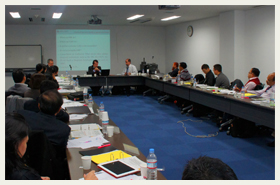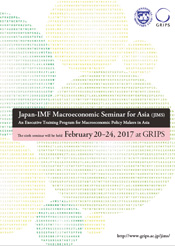Achieving Sustainable and Balanced Growth in Asia
 Although Asia remains the world's fastest growing region, there are signs of a growth slowdown. The Euro area, Japan and the US have registered positive economic growth, but the recovery is still slow. Furthermore, there is uncertainty regarding the direction of conventional and unconventional monetary policies in advanced economies and the impact these policies may have on other countries. Meanwhile, Asian developing economies face the challenge of developing their infrastructure and improving the investment climate while maintaining fiscal and financial stability. The Japan-IMF Macroeconomic Seminar for Asia (JIMS) will invite leading scholars and practitioners to share their insights on how to achieve sustainable and balanced growth in Asia. In particular, JIMS will focus on three critical issues: (1) financial stability and capital flows; (2) fiscal management and debt sustainability; and (3) structural reform and growth policies in Asia.
Although Asia remains the world's fastest growing region, there are signs of a growth slowdown. The Euro area, Japan and the US have registered positive economic growth, but the recovery is still slow. Furthermore, there is uncertainty regarding the direction of conventional and unconventional monetary policies in advanced economies and the impact these policies may have on other countries. Meanwhile, Asian developing economies face the challenge of developing their infrastructure and improving the investment climate while maintaining fiscal and financial stability. The Japan-IMF Macroeconomic Seminar for Asia (JIMS) will invite leading scholars and practitioners to share their insights on how to achieve sustainable and balanced growth in Asia. In particular, JIMS will focus on three critical issues: (1) financial stability and capital flows; (2) fiscal management and debt sustainability; and (3) structural reform and growth policies in Asia.
Managing Financial Stability and Capital Flows
The conventional model for implementing monetary policy was challenged during the 2008 financial crisis. Central banks in advanced economies responded to this challenge by implementing unconventional monetary policies. There is therefore a need to study the likely directions of monetary policy in the post-crisis world and the impact of these policies on emerging Asia. Furthermore, many Asian economies peg their currencies to the US dollar, explicitly or implicitly. A rigid exchange regime might become a source of external imbalances and could undermine the effectiveness of monetary policies. The seminar will discuss recent trends in monetary policy making and the impact they may have on Asian countries. It will also discuss the role of exchange rate policies.
Fiscal Management and Debt Sustainability
Fiscal sustainability is an important dimension of sustainable growth. The need to allocate funds for productive public investment and the challenges posed by a changing demographic structure have to be confronted with sound and realistic fiscal policies. The sovereign debt crisis in Greece and the sustainability of the Japanese public debt will be used as cases to analyze the process of debt accumulation, the consequences of a fiscal crisis, and possible policy options for crisis prevention and management.
Structural Reforms and Growth Policies in Asia
At the center of global imbalances is the imbalance between Asia and the rest of the world. Stimulating regional demand and transforming the export-oriented growth models is crucial for rebalancing in Asia. Further, developing efficient financial markets in Asia is seen as an effective means to promote portfolio investment within the region, thus mitigating capital outflows. Trade agreements and economic partnerships accompanied by appropriate measures can enhance regional integration and economic growth. Key policy options for achieving necessary structural reforms and rebalancing will be discussed under this theme.






